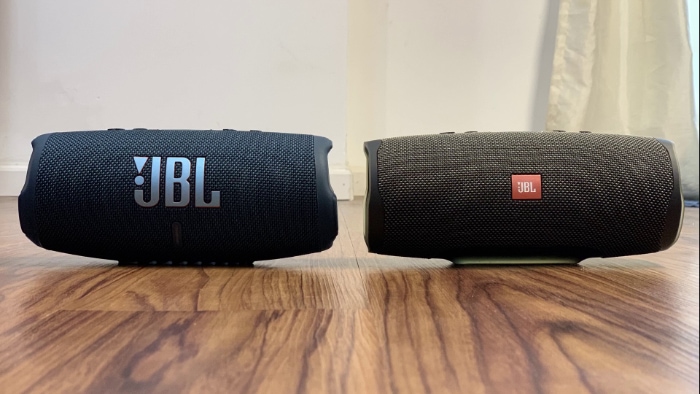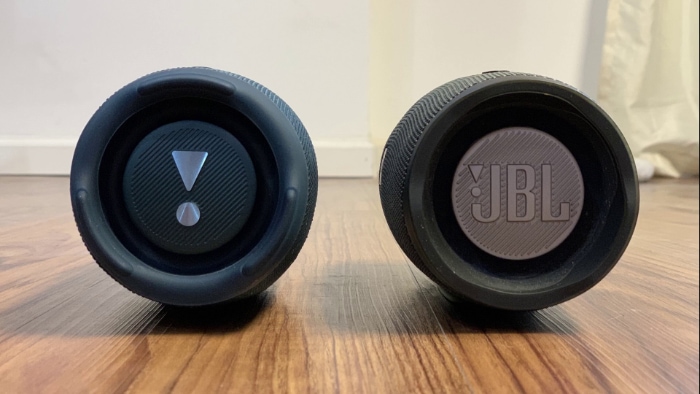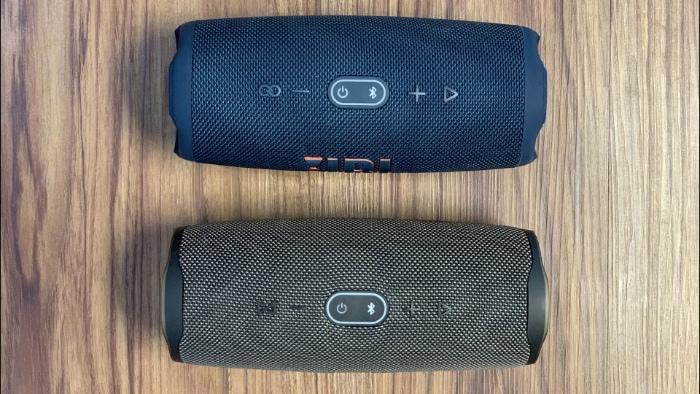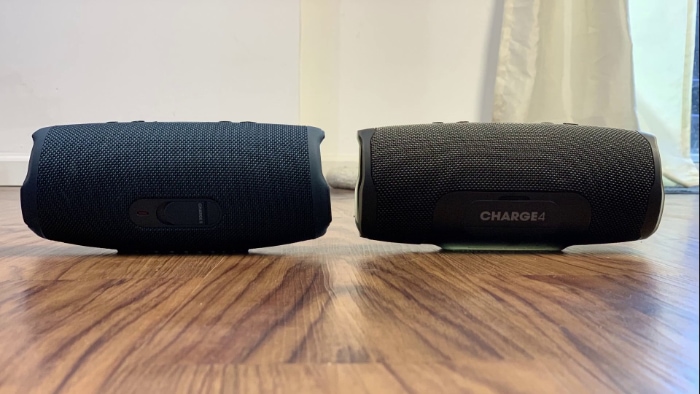JBL Charge 4 vs. Charge 5

Whether it’s home or the office, at a party, or the gym, we can always count on a portable speaker to deliver those much-needed tunes. A portable speaker eliminates the need to get a complete speaker set-up and saves us a lot of time and cost. Just charge one and start playing.
But when it comes to buying one, we have to do a lot of research before buying, so we don’t buy something we regret. We have to make sure that the device strikes the perfect balance between quality and price, and keeps us satisfied for years to come.
JBL is one of the best Bluetooth portable speakers’ best makers and has given us a vast range of different speakers to choose from. For this review, we’ve picked the JBL Charge 4 and compared it to its newer variant, the JBL Charge 5.
The JBL Charge 5 was released in 2021 and had several improvements over its previous version, which came out in 2018. But are these improvements worth the notably higher price tag? That’s what we’re going to find out.
Where to Buy?
| Seller | Price |
|---|---|
| Amazon | Check Price for JBL Charge 4 |
| Amazon | Check Price for JBL Charge 5 |
What We’re Going to Assess
In our review, we’ll be reviewing different factors about both products. These include the changes in build and design, the sound performance, the price difference, the connectivity features, the battery, and the overall quality of both the products. So, let’s get into the review!
Sound Performance

The thing that matters most for any portable speaker is the sound. You want a speaker that can fill the whole room with loud music and deliver both the highs and lows.
Some speakers are too bassy, which ruins the clarity, while others lack the deep, powerful bass that we all love. Instead, there are several parts in a speaker that work together to deliver crisp, clean sound.
First off are the drivers of the speaker. The drivers enable a speaker to deliver louder sound while keeping it clear and precise. The larger the size of the drivers, the louder and more detailed the sound is.
Passive bass radiators are simple devices built within speakers to deliver louder bass even if the speaker is small.
Speakers also have a dome tweeter, a particular type of loudspeaker designed to deliver higher frequency sounds. This is important when it comes to treble.
The wattage is also essential since higher wattage means a higher ability to deliver louder sounds.
The wattage for the JBL Charge 4 is 30 W, a 50mm x 90mm bass driver, two 65mm passive bass radiators, and no dome tweeter.
The JBL Charge 5 has some improvements over the JBL Charge 4, as it has 30W plus an additional 10W, has a slightly larger 52mm x 90mm bass driver, as well as a 20mm dome tweeter. However, the size of the passive bass radiators is the same as the JBL Charge 4.
This difference can be noted in the sound quality of the two speakers. The JBL Charge 4 is a good speaker for the price and can provide a good balance between mids and treble, with pretty good bass, good depth, and power.
The JBL Charge 5 improves on this, with more clarity and overall better sound delivery. In addition, the JBL Charge 5 excelled at higher volumes, where the JBL Charge 4 was struggling to deliver upper-mids.
For sound, the JBL Charge 5 takes the round with better overall sound performance.
Build and Design
The overall design of the two speakers is relatively the same, as both speakers are shaped like a cylinder with rounded edges.
The JBL Charge 4 has the classic JBL logo against a red background stamped in the front, whereas the JBL Charge 5 has an updated, larger logo across the front, with a simple metallic look. This seems a bit more stylish than a simple logo.
The JBL Charge 5 has a sturdier build, with rubberized edges for more reinforcement, and measures 8.7 inches x 3.76 inches x 3.67 inches. It also weighs slightly more than the JBL Charge 4.
The JBL Charge 4 measures 8.6 inches x 3.7 inches x 3.6 inches and has slightly fewer rubberized edges.
Connectivity and Interface

The JBL Charge 4 has six buttons on the speaker’s top, which controls the speaker’s power, play/pause music, Bluetooth, volume, and the JBL Connect+ feature (which allows you to connect to other JBL Connect+ devices).
The back has a rubberized cover, under which we have a USB-C charging port, a 3.5mm port for connecting headphones, and a USB-A port, which you can use to charge different devices, like your mobile phone or a music player.
The JBL Charge 5 has the same control interface on top as the JBL Charge 4, but the back now features only a USB-A charging port for devices, a USB-C charging port for the speaker, but no headphone jack. The larger rubberized cover for the ports has also been replaced by a smaller rubber cap covering only the charging port.
JBL PartyBoost
The JBL Charge 5 has the newer PartyBoost feature, only available in a few other JBL devices. This feature lets you connect to other JBL PartyBoost compatible speakers for a stereo experience or a more immersive listening session. You can connect up to a hundred devices, turning any party into a concert!
Bluetooth
Bluetooth connectivity is always essential in a portable speaker since you want to connect your phone instantly to play your favorite music. Also, you might be at a distance from the speaker, so you’d wish that the speaker doesn’t disconnect during a party or your listening session.
The JBL Charge 4 has Bluetooth 4.2, with a wireless range of up to 10m. in contrast, the JBL Charge 5 features the newer Bluetooth 5.1 version, which expands the wireless range considerably up to 40m.
The JBL Charge 5 has a better Bluetooth version, resulting in faster connecting time and longer distance covered.
Battery
The battery is crucial since you don’t want to bring a party to a stop when the speaker dies. That is why the bigger the battery, the better the playtime.
Fortunately, both the JBL Charge 4 and the JBL Charge 5 have large batteries of 7,500 mAh and are advertised to have a playtime of up to 20 hours on a single charge.
This means that both the JBL Charge 4 and the JBL Charge 5 are more than capable of giving you long hours of playtime, and you can easily charge it and keep it playing at parties or when you have extended sessions of music playing.
IP Protection
Portable speakers always need to have a good protection rating. You can always accidentally drop the device in water, or forget it outside, where it might be vulnerable to water and dust.
The JBL Charge 4 has an IPX7 rating, which means it has level 7 water sealing, meaning you can stop worrying about accidental water spills or even dropping the JBL Charge 4 into the water. However, the device’s protection against dust is unknown, so take care when using it in dustier environments.
The JBL Charge 5 has an IP67 rating, which means it’s completely sealed against water and is resistant to dust as well. The JBL Charge 5 can be dropped into a body of water to a depth of 1 meter for up to half an hour without being broken, which is excellent!
Protection-wise, both devices can be taken anywhere without worrying about spills, but the JBL Charge 5 is more protected against dust. Both the JBL Charge 4 and the JBL Charge 5 have rubberized edges, which offers some protection if you accidentally drop the speaker on the floor.
Color and Customization

Getting the right color for your speaker can be a big choice for some people. You might want the speaker to match your room, or you might want something unique looking that can be a conversation starter.
For the JBL Charge 4, these are the following color variations:
- Yellow
- Red
- Grey
- Pink
- Blue
- Sand
- Forest Green
- White
- Black
- Camouflage
- Squad
- Teal
There’s also a great feature on the JBL website that allows you to customize your designs for the JBL Charge 4, which is a fun and exciting feature not usually found in other products.
The JBL Charge 5 has the following color variations:
- Red
- Grey
- Blue
- Forest Green
- Teal
- Squad
- Black
Unfortunately, there isn’t an option to get customized designs for the JBL Charge 5.
Final Verdict
Now that we’ve talked in detail about the two products, which one is better for you?
In our opinion, the JBL Charge 5 is worth the extra price as it offers better sound performance at louder volumes and has an IP67 protection rating. In addition, the improved Bluetooth connectivity and PartyBoost feature are also worthwhile.
However, if budget’s an issue, then the JBL Charge 4 is still a pretty great option, and you’ll be satisfied with what you’re getting.
| Seller | Price |
|---|---|
| Amazon | Check Price for JBL Charge 4 |
| Amazon | Check Price for JBL Charge 5 |



